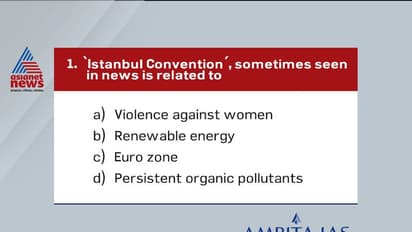സിവില് സര്വ്വീസ് പരീക്ഷ: ‘ഇസ്താംബുൾ കൺവെൻഷൻ’ എന്തുമായി ബന്ധപ്പെട്ട് നില്ക്കുന്നു ?
ഇന്ത്യന് ബ്യൂറോക്രസിയുടെ ഏറ്റവും ഉയര്ന്ന പദവികളിലേക്കുള്ള പരീക്ഷയായ സിവില് സര്വ്വീസ് പരീക്ഷയ്ക്കായി ഏഷ്യാനെറ്റ് ഓണ്ലൈനും അമൃത ഐഎഎസ് അക്കാദമിയും ചേര്ന്നൊരുക്കുന്ന ചോദ്യമാതൃകയുടെ എഴുപത്തിമൂന്നാം ഭാഗം.

Answer (a)
• Istanbul convention is also known as the Council of Europe Convention on preventing and combating violence against women and domestic violence. This is the world’s first binding instrument to prevent and tackle violence against women including domestic violence, rape, sexual assault, female genital mutilation (FGM), honor-based violence, and forced marriage.
• When a government ratifies the Convention, they are legally bound to follow it. Recently Turkey controversially withdrew from this and now Poland is also planning to move away. The interesting fact is back in 2012, Turkey was the first country to ratify the Istanbul convention.
Answer (c)
• Liberalism is ‘an ideology based on a commitment to individualism, freedom, toleration and consent’.
• The liberal theory mainly focuses on:
o Ensuring, protecting, and enlarging individual freedom
o Limiting the role and functions of the State
o Allowing state interference only when it helps an individual gain more liberty and freedom
o Making individuals the source of State and governmental power
o Advocating a doctrine of a limited political obligation
Answer (c)
Chalcolithic period Art:
- Copper age art.
- The paintings of this period reveal the association, contact, and mutual exchange of requirements of the cave dwellers of this area with settled agricultural communities of the Malwa Plateau.
- Pottery and metal tools can be seen in paintings.
- Similarities with rock paintings: Common motifs (designs/patterns like cross-hatched squares, lattices, etc)
- The difference with rock paintings: Vividness and vitality of older periods disappear from these paintings.
Answer (c)
Statement 1 is correct. The Santhal Hul (also known as the Santhal revolt) occurred in the regions of present-day Jharkhand, Odisha, and West Bengal against the British as well the Zamindari system. When the Zamindari system was introduced in the Bengal presidency, the British and the Zamindars claimed the traditional Santhal land as their own.
Statement 2 is correct. The Santhals under Sido and Kanhu rose up against their oppressors, declared the end of the Company’s rule, and asserted themselves independence in 1854. However, the British undertook extensive military operations and suppressed the rebels. A separate district of Santhal Parganas was created by the Government to pacify the Santhals.
Answer (d)
• Rash Behari Ghosh a moderate leader was the president of the Surat Congress session in 1907.
• Though he was vehemently opposed by Tilak and his colleagues he got elected into that position.
• Congress leaders split into two groups.ie; moderates and extremists at the Surat in 1907.
• Rash Behari Bose was an extremist or revolutionary leader of the Indian freedom struggle.
Answer (c)
• LEAF (Lowering Emissions by Accelerating Forest Finance) Coalition is one of the largest ever public-private efforts to protect the tropical forests.
• It is a collective program of the governments of the USA, United Kingdom, and Norway. It is working as a public-private effort, thus transnational corporations like Unilever, Amazon, Nestle, etc are supporting this program.
• Tropical forests are massive carbon sinks and by investing in their protection, public and private players are likely to stock up on their carbon credits. It will help them in achieving Nationally Determined Contributions (NDCs) under the Paris Agreement and REDD+ objectives.
Answer (d)
About BugunLiocichla
• It’s one of the few new bird species to have been discovered in India since 1947 as well as in the last decade.
• They are found only in the Singchung village of Arunachal Pradesh.
• It has been named after the Bugun tribe.
• IUCN status: Critically Endangered (CR).
• Threat: Activities like timber extraction, forest clearance, and infrastructure development have threatened its habitat.
Answer (b)
• Recently, the Union Environment Minister released the Detailed Project Reports (DPRs) of LiDAR (Light Detection and Ranging) based survey of forest areas in ten states.
• A LiDAR instrument principally consists of a laser, a scanner, and a specialized Global Positioning System (GPS) receiver. Airplanes and helicopters are the most commonly used platforms for acquiring LiDAR data over broad areas.
• LiDAR follows a simple principle — throw laser light at an object on the earth's surface and calculate the time it takes to return to the LiDAR source. Given the speed at which the light travels (approximately 186,000 miles per second), the process of measuring the exact distance through LiDAR appears to be incredibly fast.
• Lidar is commonly used to make high-resolution maps, with applications in surveying, geodesy, geomatics, archaeology, geography, geology, geomorphology, seismology, forestry, atmospheric physics, laser guidance, airborne laser swath mapping (ALSM), and laser altimetry.
Answer (d)
Priority Sector includes the following categories:
• Agriculture
• Micro, Small and Medium Enterprises
• Export Credit
• Education
• Housing
• Social Infrastructure
• Renewable Energy
• Others
Under these, a number of sub-categories are included for PSL and in the recent revision of the PSL guidelines, Bank finance to start-ups (up to ₹50 crores); loans to farmers for installation of solar power plants for solarisation of grid-connected agriculture pumps and loans for setting up Compressed Bio-Gas (CBG) plants have been included.
Answer (a)
Statement 1 is correct. The Union Commerce and Industry Ministry has announced changes in India’s Foreign Trade Policy (FTP). The Govt. has decided to continue relief under various export promotion schemes by granting an extension of the existing Policy.
Statements 2 and 3 are not correct. The benefit under all the Export Promotion Schemes (except SEIS) and other schemes, available as of date, will continue to be available for another 12 months. A decision on the continuation of SEIS will be taken and notified subsequently. The focus of the new policy is to support both the manufacturing and services sectors, with a special emphasis on improving the ‘ease of doing business.